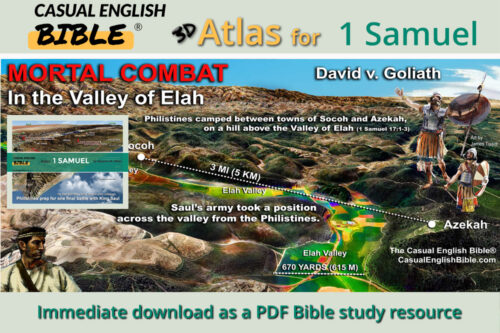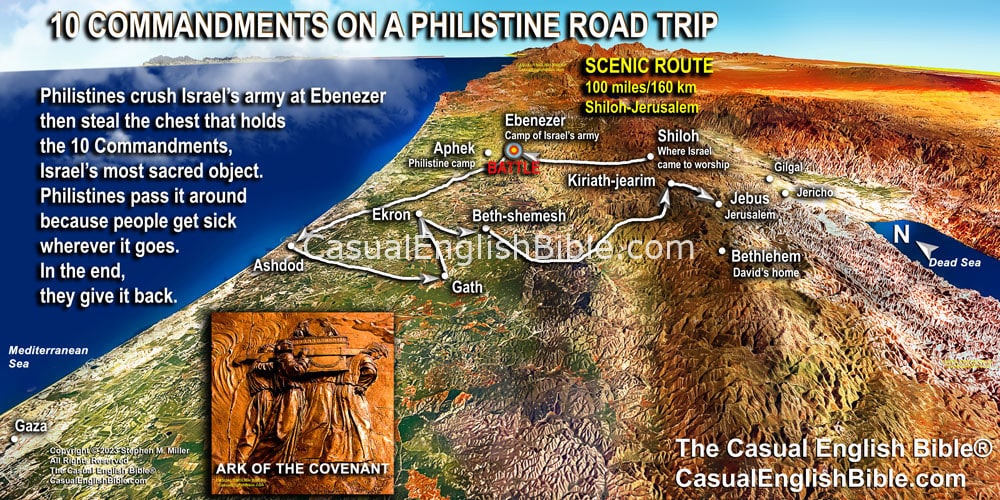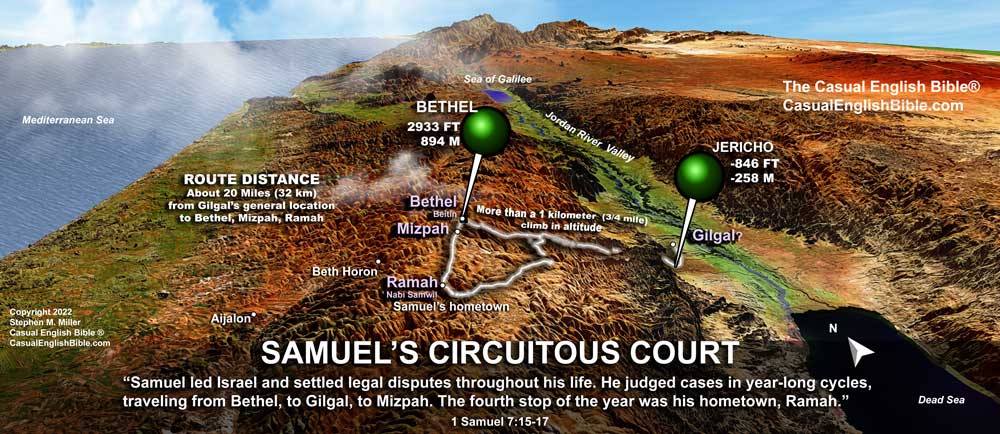1 Samuel 7
Samuel, judge and spiritual leader
Israel’s people want God again
1Citizens of Kiriath-jearim [1] came to Beth-shemesh and took the Box of the LORD [2] to the house of a man named Abinadab. [3] He lived on a hill in Kiriath-jearim. The people consecrated his son, Eleazar, so he could devote himself to preserving the Box of the Law of the LORD.2Eleazar kept the Box in Kiriath-jearim for 20 years. During that time, the people of Israel missed being able to worship God the way they had done before. 3Samuel told the people, “If you mean what you say, and you really want to go back to God, you’ve got to leave your foreign gods to get there. Get rid of those Ashtaroth [4] shrines. You need to worship God, and no one else. Do that and he’ll protect you from the Philistines.”
4So the people of Israel did it. They got rid of their idols to Baal [5] an Ashtarte.
Philistines attack prayer meeting
5Samuel said, “Okay, let’s meet at Mizpah [6] and I’ll pray to the LORD for you.”6People came from all over Israel. In an act of worship, they poured it on the ground. [7] Then they started fasting. No more food. They said, “We’re sinners. We’ve sinned against the LORD.” After that meeting, the people recognized Samuel as their leader, a judge. [8]
7Philistines found out the Israelites were meeting at Mizpah. Their leaders decided to attack Israel again, so they called up their warriors. That terrified the Israelites when they found out about it. 8So the people told Samuel, “Help us. Pray for us, Samuel, and don’t stop. Pray and keep praying. Ask God to protect us from the Philistines.”
This time, Samuel calls God
9Samuel sacrificed a lamb. He burned it all on an altar. Samuel called out for the LORD, wanting him to help Israel. The LORD answered. [9] 10Samuel was sacrificing the lamb when Philistines warriors approached, ready to attack. Suddenly the booming voice of the LORD thundered [10] through the hills. Philistines panicked. They didn’t know what to do. They ran away, routed, and Israel watched it all.11Israelite men chased Philistines down the hill and killed them on the run. They hunted them as far as Beth-car. [11]
Stone monument called “Ebenezer”
12After the victory, Samuel set up a memorial stone [12] between Mizpah and the cliff. [13] It would remind people of what God did for them. Samuel named the place Ebenezer, the “Helpful Stone.” [14] He said, “It’s the perfect name for this because the LORD helped us.”13Philistines stopped invading Israel and attacking them. Throughout Samuel’s lifetime, God kept the Philistines in check. 14Israel recaptured two Philistine cities and the surrounding land that the Philistines had taken from them: Ekron and Gath. Israelites lived peacefully alongside their Amorite [15] neighbors in the land.
Samuel Your Honor
15Samuel led Israel and settled legal disputes throughout his life. 16He judged cases in year-long cycles, traveling from Bethel, [16] to Gilgal, [17] to Mizpah. 17The fourth stop of the year was his hometown, Ramah. [18] He judged cases there, too. And he built an altar to offer sacrifices to the LORD.Footnotes
Kiriath-jearim was about 8 miles (13) northeast of Beth-shemesh. That’s a climb from the foothills at 1135 feet (346 m) to 2001 feet (610 m). It’s about the same distance from Jerusalem, further east. The huge question is “Why there and not Shiloh?” The Bible doesn’t say. One guess is that when Philistines overran the Israelite army’s camp at Ebenezer and took the Box of the Law, they continued on to Shiloh and destroyed the worship center. All three of the top priests were dead. Within the generation, Israel’s first king, anointed by Samuel, would wipe out all the remaining priests he could find (2 Samuel 22). They had apparently moved from Shiloh, south to Nob, a town next to Jerusalem. Saul thought they were helping David, whom Saul was trying to arrest and execute. David was winning the popularity contest among the common folks, and the Bible writers said Saul became insanely jealous. One priest survived Saul’s massacre: Abiathar, son of the high priest at Nob. He escaped to David. He became high priest when David became king. He was the last priest from Eli’s family.
Ark of the Covenant, a gold-covered chest that held the Ten Commandments. It was Israel’s most sacred object.
Abinadab who? Until now, the Bible never mentions him. He’s apparently not a priest or a Levite associate of priests because the Bible writer doesn’t add that. It would seem important to know if a priest or Levite was going to assume responsibility for Israel’s most sacred relic. Instead, the people seem to declare and commission their own caretaker of the box, a bit like ordaining your own preacher. Where’s Samuel when you need him? He seems to be functioning as a prophet and a circuit-traveling judge. Many regard him as the last of the famous Israelite leaders called judges, such as Deborah, Gideon, and Samson.
This god is also known as Ashtarte, the Greek form of her name. Like Baal, she was a god of fertility. But she was also a go-to god for matters of love and war. Sometimes she’s described as Baal’s wife. Her figurines portray her as well-endowed, and then some—with her privates exposed and prominently displayed.
The Hebrew word is plural, baalim. Some scholars say this refers to different forms of the main Canaanite god, Baal. He was a god of weather and fertility in family, flocks, and fields. People worshiped him using different styles of idols and by calling him various names: Hadad, Cloud Rider, Baal of [fill in whatever the local region was, such as Baal-zephon or Baal of Peor]. Peor was a mountain in Moab where people worshiped Baal. Baal of Peor was apparently a local representation of him. When women from Moab seduced some of the Israelite men to engage in either ritual sex or just plain ol’ illicit sex, it led the men into idolatry (Numbers 25).
Location of Mizpah is uncertain. Top contender is a ruin called Tell en-Nasbeh, beside the modern settlement of Psagot. The ruin is in the Judean hills about eight miles (13 km) north of Jerusalem. It’s about half a mile high, at an altitude of about 1,560 feet (780 meters). The closest Philistine town was Ekron, on the coast, a hard day’s climb for Philistines coming to attack—about 23 miles (38 km).
The writer doesn’t say why the people poured water on the ground. But based on the people’s confession of sin, the water likely had something to do with an expression of sin. Perhaps the water symbolizes their sins or their prayers, poured out to God. Or maybe it marks the beginning of their fast from food and water while Samuel prays for them and while they pray, too.
Bible scholars generally consider Samuel the last of the famous “judges,” heroic leaders of Israel such as Deborah, Gideon, and Samson. But Samuel was also a trial judge, like the prophetess Deborah. She settled disputes under a tree called the “Palm of Deborah” (Judges 4:5). Samuel, however, was a circuit-riding judge. He settled disputes in his hometown of Ramah and three other towns: Bethel, Gilgal, and Mizpah (1 Samuel 7:16).
This is a reversal in the story, reminding us of God calling young Samuel many years ago, and Samuel answering him.
This is most likely thunder instead of God with baritone vocal cords. Throughout the Bible, God often uses the laws of physics to get the job done. He dams the Jordan River so the people can cross during flood season (Judges 3:16). In war, he used lightning, darkness, hail, and disease (1 Kings 18:38; Joshua 24:7, Exodus 9:25, 1 Samuel 5:6).
Beth-car’s location is uncertain. One contender is Ain Karim, almost 5 miles (8 km) west of what would later become the Jerusalem Temple. If locations of Mizpah and Beth-car are correct, or almost correct, Israel’s army traveled a half-day’s walk away, 10 miles (16 km). If Philistines attacked in the morning, the Israelites could have gotten back to Mizpah in time for supper.
There are a lot of stones in what are now Israel and Palestinian Territory. People in Bible times used them many ways: to build walls, houses, and altars. They also used them to mark important places, such as Jacob’s dream at Bethel and Israel’s first camp in the Promised Land, at Gilgal (Genesis 28:22; Joshua 4).
The Hebrew word is Shen, which can mean a rock feature such as a cliff, crag, or a projection that looks like a tooth. It may have been where Israelites stopped chasing the Philistines. The location is unknown.
What an odd name, given that Philistines demolished Israel’s army at another location called Ebenezer 20 years earlier. Yet this story reads like another reversal of a past even. In the first reversal, Samuel calls for God (7:9). In this reversal, Israel wins the battle of Ebenezer. The name means “helpful stone” or “stone of help.”
A group of people living in Canaan, today’s Israel and Palestinian Territories.
Bethel is where the Israelites, centuries earlier, had pitched their tent worship center (Judges 20:27). This worship center was where they went to consult God through the priest, and to offer sacrifices. In Samuel’s day, the tent seemed to be gone, perhaps destroyed by Philistines when they captured the sacred box containing the Ten Commandments.
Samuel’s Quad-City Circuit didn’t cover much territory in Israel. Every city seemed within a day’s walk of Jerusalem. It’s uncertain where Gilgal was. Contenders include several dirt-covered mounds of ruins near Jericho. No winners yet. Israel’s invasion of Canaan took the people there. It was described as their camp and staging ground for the coming attack on nearby Jericho (Joshua 4:19).
Ramah is usually linked to ruins called Al-Ram. It’s about 5 miles (8 km) north of Jerusalem. Some scholars link Rama to another ruin about five miles southwest, Nabi Samwil. At the time, Jerusalem was still a generation away from when King David would capture it and turn it into his capital, the City of David.
Discussion Questions
- Sorry, there are currently no questions for this chapter.







